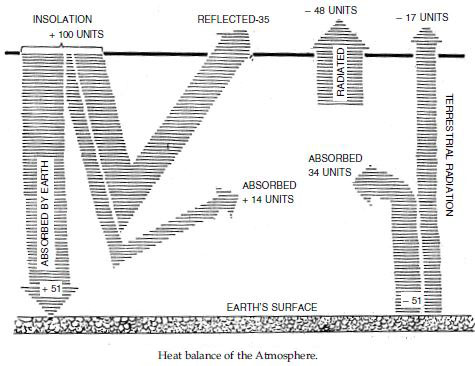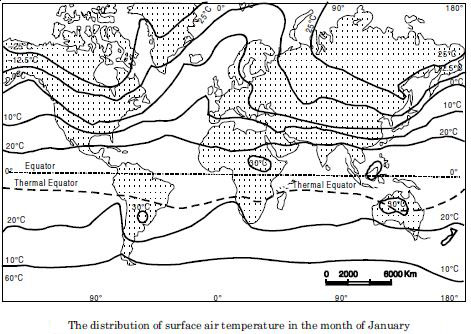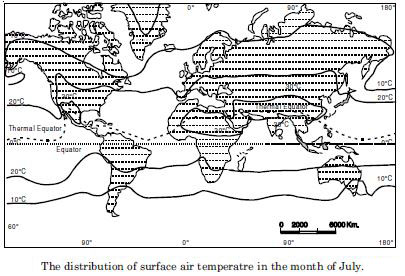Question 1:
The sun is directly overhead at noon on 21st June at :
- The equator
- 23.5° S
- 23.5° N
- 66.5° N
Answer:
(c). 23.5° N
Question 2:
In which one of the following cities, are the days the longest?
- Tiruvanantapuram
- Chandigarh
- Hyderabad
- Nagpur
Answer:
(b). Chandigarh
Question 3:
The atmosphere is mainly heated by the:
- Short wave solar radiation
- Reflected solar radiation
- Long wave terrestrial radiation
- Scattered solar radiation
Answer:
(c). Long wave terrestrial radiation
Question 4:
Make correct pairs from the following two columns.
- Insolation
- Albedo
- Isotherm
- Annual range
Answer:
(i) (c);
(ii) (d);
(iii) (b);
(iv) (a)
Question 5:
The main reason that the earth experiences highest temperatures in the subtropics in the northern hemisphere rather than at the equator is:
- Subtropical areas tend to have less cloud cover than equatorial areas.
- Subtropical areas have longer day hours in the summer than the equatorial.
- Subtropical area have an enhanced ‘‘green house effect’’ compared to equatorial areas.
- Subtropical areas are nearer to the oceanic area than the equatorial locations.
Answer:
Subtropical areas tend to have less cloud cover than equatorial areas.
Question 6:
How does the unequal distribution of heat over the planet Earth in space and time cause weather and climate?
Answer:
Temperature is not uniformly distributed on the earth surface. Due to variation of insolation, different types of climate and weather are observed on the surface of the earth. Lower temperatures are found in equatorial region as compared to tropical region.
Question 7:
What are the factors controlling temperature distribution of the surface of the earth?
Answer:
The temperature of a place on the surface of
the earth depends upon :
(1) Latitude of the place
(2) Altitude
(3) Distance from the sea
(4) Air mass circulation
(5) Warm and cold currents
(6) Local impacts.
Question 8:
In India, the day temperature is maximum in May and why not after summer solstice?
Answer:
May is the hottest month in India. The sun shines vertically over Tropic of Cancer. After that, after 21st June, the rainy season sets in. S.W. Monsoons give heavy rainfall. Due to rains, the temperature falls by 7°C.
Question 9:
Why annual range of temperature is very high over Siberian plains?
Answer:
Siberian plains are located north of Arctic circle (66½°N latitude). It has high annual range of temperature due to continentality. In Summer, the mean temperature is 10°C. But in winter the temperature ranges between—18°C to -48°C. With the result the annual range of temperature is about 60°C.
Question 10:
How do the latitude and tilt of the axis of rotation of the earth affect the amount of radiation received at the earth’s surface?
Answer:
The amount of incoming solar radiation
is called insolation. This depends upon the angle of
incidence of sun’s rays.
(a) Vertical rays cover a smaller area. It gives more
heat per unit area. The equatorial region recives vertical
rays and maximum insolation.
(b) Vertical rays cover a small area through
atmosphore. So absorption of heat is less. Vertical rays
are hotter than slanting rays.
Question 11:
Discuss the processes through which the earth atmosphere system maintains heat balance.
Answer:
Sun is the most important source of
atmospheric heat. The atmosphere absorbs only 14%
of insolation passing through it. This amount is not
effective in heating atmosphere. The atmosphere is
not heated directly by the sun through short wave
radiation. It is indirectly heated by long wave radiation
from the earth below. The following processes are
involved in heating the atmosphere :
1. Conduction. Conduction is the process in which the
heat flows from a region of higher temperature to region of
lower temperature through contact. The land absorbs
insolation and warms up the above air slowly. As air being
a gas, has a very low conductivity, conduction is not a
major process of heating the atmosphere.
2. Convection. Convection is the most important
process of heating the atmosphere. It is a process of
transferring the heat from a hotter to a colder region
through vertical descending or ascending air currents.
When the air of the lower layer gets heated, it expands
and rises upward as ascending winds. The colder air
descends down to take its place on the earth. A cyclic
circulation of convection currents helps in distributing
the heat of lower layers to upper layers.
3. Terrestrial Radiation. The atmosphere is
mostly heated by outgoing long wave earth radiation.
The earth absorbs 51% of short wave solar energy. The
earth’s surface radiates this energy as long wave solar
energy. The heating up of atmosphere through this
outgoing radiation is called the process of radiation.
4. Advection. Advection means horizontal transfer of
heat by winds from a hotter to colder region. The air
temperature of a place will rise if the air mass is coming
from a warmer area. A cold air mass will reduce the
temperature of a warmer region.
5. Compression. When the mass of the air descends, it
is being compressed in volume. As a result of compression,
the temperature in lower layers is increased.
Heat Budget. The average annual temperature of the
earth as a whole is neither decreasing nor increasing. It
remains almost constant. The incoming solar radiation
is balanced by an equal amount of outgoing radiation
returned from the earth. A balance is maintained
between the insolation received by the earth and the
radiation returned from the earth. This is known as
heat budget.
Incoming Solar Radiation :
Let us assume that the total heat received at the top
of atmosphere is =100 units.
Heat lost
Loss of heat due to scattering = 6%
Loss of heat due to reflection = 27% (by clouds)
Loss of heat due to reflection = 2% (by earth)
Heat absorbed by the atmosphere = 14%
Total loss = 49%
Heat received at the earth surface = 100 – 49 = 51%
Thus, only 51% of insolation reaches the earth surface,
the remaining 49% is reflected back and is known as
Earth’s Albedo.
Out-going terrestrial radiation :
By convection = 9%
By evaporation = 19%
Absorbed by atmosphere = 6%
Radiation from the earth’s surface = 17 %
Total radiation = 51%
(given out by the earth)
It can be seen that the total of 51 units of heat
received from the sun is returned back by the earth
for the heating up of atmosphere.

Question 12:
Compare the global distribution of temperature in January over the Northern and Southern hemispheres of the Earth.
Answer:
The horizontal distribution of temperature is
shown by isotherms. The distribution of temperature
varies from one season to another. January and July
represent the seasonal extremes of temperature.

January Isotherms.
(1) The highest temperature occurs over land areas.
A temperature of more than 30° C occurs on the land
masses of southern hemisphere along the Tropic of
Capricorn.
(2) The lowest temperature of – 32° C occurs in
Verkhoyansk in Siberia.
(3) In the northern hemisphere, the isotherms bend
equatorward over the land masses and poleward over
the oceans. In the southern hemisphere, the condition
is reverse.
(4) Isotherms are irregular in northern hemisphere
but in the southern hemisphere the isotherms are more
regular and run east to west.
(5) Isotherms are closely spaced in northern
hemisphere and widely spaced in southern hemisphere.
July Isotherms. It is summer in the northern
hemisphere and winter in southern hemisphere.
(1) The maximum temperature of more than 30° C
occurs on the land masses between 10°N – 40°N.
(2) The minimum temperature of below zero degree
centigrade is observed in the Central Greenland.
(3) The isotherms bend equatorward on the oceans
and poleward on the land masses in the northern
hemisphere.
(4) Isotherms are more widely spaced on the oceans
than on the continents.
(5) Due to excess of water, isotherms are more
regular in the southern than in the northern
hemisphere.

